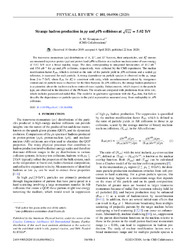Strange hadron production in pp and pPb collisions at √sNN = 5.02 TeV
| dc.contributor.author | Sirunyan, A. M. | |
| dc.contributor.author | Işıldak, Bora | |
| dc.date.accessioned | 2020-11-24T08:54:37Z | |
| dc.date.available | 2020-11-24T08:54:37Z | |
| dc.date.issued | 2020-06-22 | |
| dc.identifier.issn | 0556-2813 | en_US |
| dc.identifier.uri | http://hdl.handle.net/10679/7133 | |
| dc.identifier.uri | https://journals.aps.org/prc/abstract/10.1103/PhysRevC.101.064906 | |
| dc.description.abstract | The transverse momentum (pT) distributions of Lambda, Xi(-), and Omega(-) baryons, their antiparticles, and K-S(0) mesons are measured in proton-proton (pp) and proton-lead (pPb) collisions at a nucleon-nucleon center-of-mass energy of 5.02 TeV over a broad rapidity range. The data, corresponding to integrated luminosities of 40.2 nb(-1) and 15.6 mu b(-1) for pp and pPb collisions, respectively, were collected by the CMS experiment. The nuclear modification factor R-pPb, which is defined as the ratio of the particle yield in pPb collisions and a scaled pp reference, is measured for each particle. A strong dependence on particle species is observed in the pT range from 2 to 7 GeV, where R-pPb for K-S(0) is consistent with unity, while an enhancement ordered by strangeness content and/or particle mass is observed for the three baryons. In pPb collisions, the strange hadron production is asymmetric about the nucleon-nucleon center-of-mass rapidity. Enhancements, which depend on the particle type, are observed in the direction of the Pb beam. The results are compared with predictions from EPOS LHC, which includes parametrized radial flow. The model is in qualitative agreement with the R-pPb data, but fails to describe the dependence on particle species in the yield asymmetries measured away from midrapidity in pPb collisions. | en_US |
| dc.description.sponsorship | BMBWF and FWF (Austria); FNRS and FWO (Belgium); CNPq, CAPES, FAPERJ, FAPERGS, and FAPESP (Brazil); MES (Bulgaria); CERN; CAS, MoST, and NSFC (China); COLCIENCIAS (Colombia); MSES and CSF (Croatia); RPF (Cyprus); SENESCYT (Ecuador); MoER, ERC IUT, PUT and ERDF (Estonia); Academy of Finland, MEC, and HIP (Finland); CEA and CNRS/IN2P3 (France); BMBF, DFG, and HGF (Germany); GSRT (Greece); NKFIA (Hungary); DAE and DST (India); IPM (Iran); SFI (Ireland); INFN (Italy); MSIP and NRF (Republic of Korea); MES (Latvia); LAS (Lithuania); MOE and UM (Malaysia); BUAP, CINVESTAV, CONACYT, LNS, SEP, and UASLPFAI (Mexico); MOS (Montenegro); MBIE (New Zealand); PAEC (Pakistan); MSHE and NSC (Poland); FCT (Portugal); JINR (Dubna); MON, RosAtom, RAS, RFBR, and NRC KI (Russia); MESTD (Serbia); SEIDI, CPAN, PCTI, and FEDER (Spain); MOSTR (Sri Lanka); Swiss Funding Agencies (Switzerland); MST (Taipei); ThEPCenter, IPST, STAR, and NSTDA (Thailand); TUBITAK and TAEK (Turkey); NASU (Ukraine); STFC (United Kingdom); DOE and NSF (USA). Individuals have received support from the MarieCurie program and the European Research Council and Horizon 2020 Grants, Contracts No. 675440, No. 752730, and No. 765710 (European Union); the Leventis Foundation; the A.P. Sloan Foundation; the Alexander von Humboldt Foundation; the Belgian Federal Science Policy Office; the Fonds pour la Formation a la Recherche dans l'Industrie et dans l'Agriculture (FRIA-Belgium); the Agentschap voor Innovatie door Wetenschap en Technologie (IWT-Belgium); the F.R.S.-FNRS and FWO (Belgium) under the "Excellence of Science-EOS"-be.h project No. 30820817; the Beijing Municipal Science & Technology Commission, No. Z181100004218003; the Ministry of Education, Youth and Sports (MEYS) of the Czech Republic; the Lendulet ("Mo-mentum") Program and the Janos Bolyai Research Scholarship of the Hungarian Academy of Sciences, the New National Excellence Program UNKP, the NKFIA research Grants No. 123842, No. 123959, No. 124845, No. 124850, No. 125105, No. 128713, No. 128786, and No. 129058 (Hungary); the Council of Science and Industrial Research, India; the HOMING PLUS program of the Foundation for Polish Science, co-financed from European Union, Regional Development Fund, theMobility Plus program of theMinistry of Science and Higher Education, the National Science Center (Poland), contracts Harmonia 2014/14/M/ST2/00428, Opus 2014/13/B/ST2/02543, 2014/15/B/ST2/03998, and 2015/19/B/ST2/02861, Sonata-bis 2012/07/E/ST2/01406; the National Priorities Research Program by Qatar National Research Fund; the Ministry of Science and Education, Grant No. 3.2989. 2017 (Russia); the Programa Estatal de Fomento de la Investigacion Cientifica y Tecnica de Excelencia Maria de Maeztu, Grant MDM-2015-0509 and the Programa Severo Ochoa del Principado de Asturias; the Thalis and Aristeia programs cofinanced by EU-ESF and the Greek NSRF; the Rachadapisek Sompot Fund for Postdoctoral Fellowship, Chulalongkorn University and the Chulalongkorn Academic into Its 2nd Century Project Advancement Project (Thailand); the Nvidia Corporation; the Welch Foundation, contract C-1845; and the Weston Havens Foundation (USA). | |
| dc.language.iso | eng | en_US |
| dc.publisher | American Physical Society | en_US |
| dc.relation.ispartof | Physical Review C | |
| dc.rights | openAccess | |
| dc.title | Strange hadron production in pp and pPb collisions at √sNN = 5.02 TeV | en_US |
| dc.type | Article | en_US |
| dc.description.version | Publisher version | en_US |
| dc.peerreviewed | yes | en_US |
| dc.publicationstatus | Published | en_US |
| dc.contributor.department | Özyeğin University | |
| dc.contributor.authorID | (ORCID 0000-0002-0283-5234 & YÖK ID 124605) Işıldak, Bora | |
| dc.contributor.ozuauthor | Işıldak, Bora | |
| dc.creator | The CMS Collaboration | |
| dc.identifier.volume | 101 | en_US |
| dc.identifier.issue | 6 | en_US |
| dc.identifier.wos | WOS:000541703200002 | |
| dc.identifier.doi | 10.1103/PhysRevC.101.064906 | en_US |
| dc.identifier.scopus | SCOPUS:2-s2.0-85093091903 | |
| dc.contributor.authorMale | 1 | |
| dc.relation.publicationcategory | Article - International Refereed Journal - Institutional Academic Staff |
Files in this item
This item appears in the following Collection(s)
Share this page



